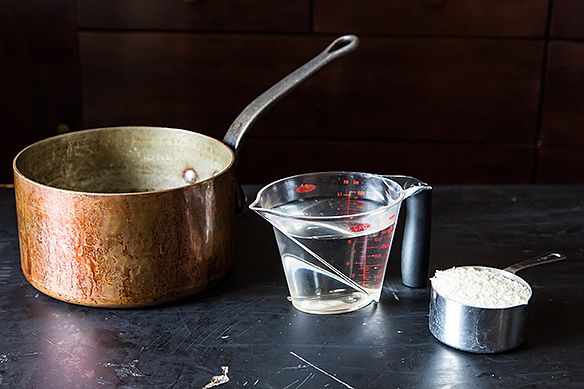
In all likelihood, there is an island, or at the very least, counters that go on for miles, on which you chop, dice, and mix. (You set up separate stations for each, just because you can.) There are appliances and tools ready for you at your every mixing and churning whimsy, places to bake, and then to cool, all of your latest creations. And somewhere—maybe above the stove, maybe beside it—there are likely copper pots, beautiful and shining and ready to simmer.
Shop the StoryBut copper pots and pans are for more than just daydreams, for mind movies of cooking alongside Julia Child and flipping your own perfect omelette. There’s a reason these, to some, are the crème de la crème of cookware. For those of you who are lucky enough to own them—or those who’d just like to treat them properly in the kitchens of their dreams—we’re talking copper.
Copper doesn’t just make your stove stylish, it lends you a helping hand while you cook. As a metal, copper is one of the best conductors of heat: It warms quickly and stays warm, making for an even distribution of heat, and—here’s the best part—uniform cooking of your food. This means no more burnt spots, no more scalding. You have greater control over everything. See? Helping hand.
And while we have you, a rumor we'd like to dispel: Copper is 100% safe to cook in, so long as it is lined with another, non-reactive metal (and most copper cookware is). Most commonly, you'll find linings made of nickel, tin, or stainless steel. Throw anything and everything into these pans; the metal lining will keep you—and your food—safe.
An exception: There are certain kinds of copper cookware, like egg white whipping bowls and jam pans, that actually harness copper's reactive qualities to do their job more effectively—stabilizing the proteins in egg whites, and responding to to changes in temperature quickly, for extra precision while you’re cooking down your jams, respectively. For that reason, they won't be lined with a non-reactive metal, but they are safe to cook with as directed.
Be nice to your copper. Trust your copper. Copper is the decathlete of metals—it’s ready to do most anything you ask of it, effortlessly. Since it’s extremely efficient with heat, there is generally no need to use a high flame, or to preheat before cooking. Keep your heat moderate, and let the pan do the rest of the work.
If you accidentally got a little impatient with the heat and cranked the flame, discoloration could occur. If this happens, not to worry, there’ll just be a Wright’s Copper Cleaner (or Brasso) and a bit of elbow grease in your future.
Not true! One of the great myths of copper cookware is that it is difficult to care for. We are dispelling that, right here and now. Copper pots are built to last—built to boil, sauté, and braise with the best of them—and come out the other side alive. Most importantly, the majority of battle scars they incur can be successfully healed with just a pantry and a little patience.

Follow these simple tips and home remedies, and your copper cookware is bound to last, too:
Unless the lining is cracked or flaking, exposing the copper underneath, a naturally worn and patinaed pan is perfectly safe to cook with. If the lining is worn through to reveal the copper underneath, do as Beth Sweeney of Coppermill Kitchen does and send it off to be professionally re-tinned. Some professionals that our readers have recommended include: East Coast Tinning, L.J. Gonzales, and Brooklyn Copper Cookware.
This post originally ran in 2012 (vintage!), but we've spruced it up (to include some additional tips, and several of yours from the comments!) and shared it anew to help anyone caring for copper cookware this season.
Do you cook with copper? Share your best tips for polishing and care in the comments (and shop for it, here).
It's here: Our game-changing guide to everyone's favorite room in the house. Your Do-Anything Kitchen gathers the smartest ideas and savviest tricks—from our community, test kitchen, and cooks we love—to help transform your space into its best self.
See what other Food52 readers are saying.